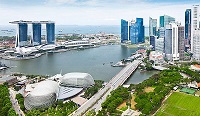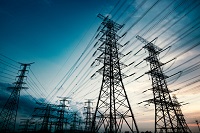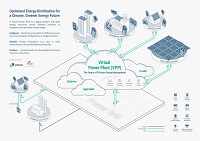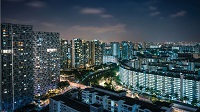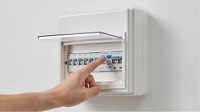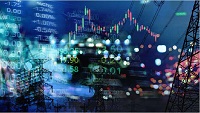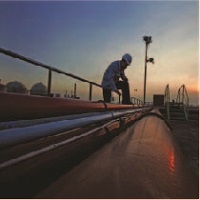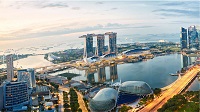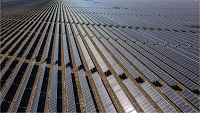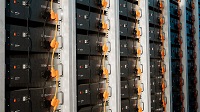A Singapore Government Agency WebsiteHow to identify
Official website links end with .gov.sg
Government agencies communicate via .gov.sg websites
(e.g. go.gov.sg/open).Trusted websites
Secure websites use HTTPS
Look for a lock ( )or https:// as an added precaution. Share sensitive information only on official, secure websites.
Co-Creating Singapore’s Energy Future
Good morning
Trends and Implications
2. Energy is changing. Singapore today is powered 95% by natural gas, generated by just over a handful of companies. Solar, the most viable renewable energy in Singapore’s context, is growing. As of Q1 2017, the total number of grid-connected installations was just under 2,000 contributing close to 130 MWp. This total installed base is roughly doubling every year. This is the first big change. The rise of distributed generation. The grid that was originally designed to carry electricity one way, has to now accommodate its two-way flow.
3. The second big change is that there are more and more active connections into the grid. This includes smart meters that enable time of use pricing, allowing loads to respond to the real time price of electricity. It also includes electric vehicles and energy storage that not only draw power to charge but are also able to inject energy back into the grid. If managed in the interest of the larger system, these can help improve the resilience and stability of the grid. If mismanaged, they can amplify stresses to the detriment of the larger system.
4. Thirdly, with more connections to the grid the risks of cyber-attacks will only increase. This is further exacerbated as infrastructures - energy, water, transport, and telecommunication - become more intertwined. How do we fully appreciate and defend the grid, and also mitigate knock on effects from one system to the next?
5. The fourth big change has to do with the increasing complexity of the grid and its aging infrastructure. Life used to be simple. A new system, with proper maintenance, has a high level of reliability. As systems age, is there a better way to monitor the health of the system and to preempt breakdowns.
6. Also, in Singapore’s unique context, with the increasing myriad of underground infrastructure, is there a way to better manage and maintain our underground infrastructure, and to prevent accidental damages.
7. Lastly, with the digitalization of the grid, what new opportunities do they present and how must technology and policy evolve to meet this need.
Energy Trilemma
8. Before I proceed to talk about how we can co-create the future of energy together, let us take a step back to look at energy through the lens of the energy trilemma.
9. It is said that if you are a hammer, everything looks like a nail. Unfortunately for energy policy makers, the energy nail has 3 dimensions. It is not just one nail.
10. The first leg of the trilemma is that of energy security. This is about keeping the lights on and the gas flowing. It is not just about making sure electricity flows but flows with a certain level of reliability and quality.
11. Distributed generation like solar is intermittent. When the installed base is small the system is able to absorb these fluctuations. As it grows, the ability to forecast these fluctuations become important. With that in mind we have reached out to the Meteorological Service Singapore and the R&D community to develop new approaches to forecasts irradiance, and the associated algorithms to better manage the grid. We have 6 very good proposals and hope to announce the winner or winners by SIEW of this year.
12. Another project to study strategies for grid wide intermittency management is a proposal by Assistant Prof Tang Yi of NTU with Sunseap Leasing and Panasonic Asia Pacific. This project, funded through one of the previous grant calls, aims to connect lithium-ion batteries at multiple HDB blocks under a centralized control system to effectively manage the fluctuating output of solar.
13. Energy security is also about better sense and response capabilities of the system. Singapore energy sector is no different from water. Just like water sector, there is better security with diversifying of sources. Before 2013, all our natural gas came from Malaysia and Indonesia via pipelines. It was only in 2013, with the commissioning of the LNG terminal were we able to diversify our sources of natural gas.
14. One of the themes in our recent grant call is on the area of resilience. Can we use big data or deep learning algorithms to better understand what is happening and take preemptive measures?
15. The second leg of the trilemma is that of environmental sustainability. How can we reduce the environmental impact of the grid? From a fuel mix perspective we have already moved to natural gas, the cleanest of the fossil fuels. Can we get more out of each unit of gas? In past grant calls we have funded projects that look at how to optimize the operating performance of a gas turbine. Is there more that can be done?
16. Reducing consumption is another way to improve the environmental footprint of the overall system. BCA aims to have 80% of buildings green certified by 2030. On the industrial EE front, NEA and EDB intends to raise the annual improvements for EE to achieve 1–2% per annum.
They intend to do this through schemes such as the Productivity Grant and EE Financing to help industries lower the cost of EE, and improve the return of investments on EE investments.
17. The third leg is energy affordability. This is about the cost of access to energy to users. It is about cost competitive energy for our industries and businesses. What this consideration tells us is that whatever measures we undertake needs to be weighed against the value they bring. About 5 years ago, there was a lot of pressure for Singapore to consider feed in tariffs for solar. We held our ground on the belief that it would not be sustainable and was eventually proved right in this decision. Feed in tariffs would have just ended up in escalating costs of the overall system.
18. It is about trade-offs. Singapore’s grid is one of the world’s most reliable. Some would even argue too reliable and have posed the question if there is room to sacrifice some reliability for a cheaper cost. On the other hand, there are businesses that require even higher reliability than what we have. Should this be provided as a service or left to the end user? Can we make better trade-offs between affordability and reliability? With that in mind we are in discussions with Singapore Power and the R&D community to study microgrids and the role that they could play as part of our future energy system.
19. The idea is to have a grid with baseline reliability that would meet the needs of most users at an affordable cost. For those that require higher reliability, they could be met by a dedicated microgrid within the main grid.
20. That is the trilemma. Security, sustainability and affordability. Through our different policy choices, we try and balance these different, sometimes conflicting priorities, to meet the needs of the different users.
Preamble on R&D
21. Now R&D is not the panacea for all out problems. We are a small country and whatever budget we have for R&D is never enough. So the first consideration is make or buy? Some challenges like haze is unique to S.E Asia. If we don’t invest in it, no one will.
22. Haze affects the air intake of our plants. A few years ago we funded a project by Mr Mohan Dass from NTU with Tuas Power and the Sustainable Energy Association Singapore, to look for an affordable and better solution than whatever is available on the market. Unique problems requires unique solutions.
23. Sometimes we also fund projects because a solution has never been deployed in an environment like ours. Grid energy storage is one example. It is well known that performance degrades in tropical environment. But how much and what is the best way to operate them, that is not known. We hope to answer some of these questions through working with Singapore Power on an energy storage systems test-bed.
24. Other times, our motive of funding a research is to build up world class science in the particular space. If we can bring the technology to commercialization we not only solve a national imperative, but we also seed a made-in-Singapore solution that has economic spinoff. The technology that went into Evercomm’s product to optimize energy required in the running of a data center is a good example.
Solving Well Defined Problems
25. So coming back to R&D. I see 4 modes that we can work with the R&D community. Firstly, the industry has some well-defined problems looking for solutions. Most of the projects we have funded in the past are along this line. An industry player comes up with a problem statement, and the R&D community rallies round to propose a specific solution.
26. Singapore Power has a problem in detecting illegal ground excavations near their gas pipelines. It is a uniquely Singapore problem given our build density not just above ground but also underground. We funded a project by Singapore Power, ST Electronics and the Institute of Infocomm Research (I2R). The project aims to develop a cost competitive sensing solution to detect illegal earth works. The final solution, a Fibre Optic Sensing System (FOSS), was able to detect unauthorized work activities and have the information transmitted to SPPG’s operation centre or to designated mobile devices for swift and timely response. The project has proven successful, and Singapore Power will be conducting more extensive field tests of the FOSS before large-scale deployments along our gas networks. Once deployed, damage to gas pipelines from unauthorized work activities will hopefully be reduced through timely detection and response.
Co-creating Solutions
27. Solutions sometimes don’t exist by themselves, but require changes to policies in order to take off. The second mode of collaboration is where technology and the associated policy frameworks come together. A good example is demand response. In 2010, we funded a project by Red Dot Power to see if loads would be willing to curb demand in exchange for monetary payments.
28. The demand response pilot identified more than 40 MW of load that were willing to be curtailed for monetary payments. With the confidence of this project, we formulated and launched the demand response policy framework.
29. More recent examples include our energy storage systems test-bed, whose deployment will help inform SCDF on the fire safety regulations required, and would also inform EMA on the policy framework for grid storage.
30. In line with CFE recommendations, we have just launched a consultation on the framework for regulatory sandboxing for the energy sector. This is more than technology but would also include new business models. The framework would allow businesses, in partnership with the regulator, to co-create the future of energy. The consultation paper seeks views on sandboxing guidelines – like the processes for conducting the sandbox, criteria for the projects, and proposed changes to existing regulations and rules to address current regulatory barriers.
31. Sometimes it is also not about just technology and policy but technology and operations. I spoke earlier about integrating weather forecasting to predict solar irradiance to inform policies on operating the grid.
32. To do that the teams would need to work closely with the end users to make sure that operational considerations are factored early into the algorithm designs. Don’t work on solutions that are theoretically perfect but operationally unusable. Please engage the regulator or the eventual end users early.
System Level Solutions
33. The third mode is when we work together on system level solutions. Through early planning, and taking a systems approach to our challenges, we are able to look at needle movers to the trilemma that we would not be able to do otherwise.
34. We know that a generator that is used for steam, cooling and electricity can operate at a much higher efficiency level than one used just for electricity. In order to tap on this, we would need to plan for heat and cooling demands in the vicinity of the generator. What if we took it even one step further and planned for load profiles of the neighborhood to be counter cyclical. So that at the aggregated level, the demands for electricity, heating and cooling is essentially flat in that district. What if we then manage the cooling, heating and electricity network as a system of systems, rather than as 3 independent networks?
35. There was such an experiment in Osaka, Japan. By leveraging synergies between district infrastructures, the Smart Energy Network which integrated solar PV, large scale co-generation power plants and centralized heating claimed an energy efficiency output of more than 84%. This is significantly higher as compared to CCGT F class efficiency of approximately 55%.
36. Can we take this example and up it a notch? Can we use block chains to optimize the generation and use of building integrated solar within that neighborhood? How can we work with the research community to catalyze more of such system of system solutions? Are there other bold ideas that require the public, private and research community to come together to better plan and to co-create our future?
Being the Eyes and Ears
37. The last mode of collaboration I would like to touch on is the role of the research community to be the eyes and ears of policy makers, and to challenge our paradigms of what our energy future can be. Be it new storage technologies based on glass by Lithium-ion battery co-inventor Prof John Goodenough, or space based solar, or promising carbon capture and utilization technologies that are emerging. Ideas that just yesterday was not economically viable, through technology breakthroughs, can become our solutions of tomorrow.
38. I attended an NUS workshop on space based solar in May this year. The takeaway was that space based solar is not as far-fetched as one might think and it is an area we really need to keep a watching brief on.
39. You are at the forefront of technology. How can the research community work with policy makers in this area?
Creating Economic Engines of Growth
40. If we do this right, we not only solve our national challenges but we seed new economic engines and businesses for Singapore. The government’s relationship with Red Dot Power started with an R&D project on demand response. The company has grown to be an integrated energy solutions provider offering demand response, interruptible load and retail electricity in Singapore. Currently, Red Dot Power also has the largest market share among the independent electricity retailers.
41. A second example is Sunseap. Sunseap started when solar PV take-up was just taking off. As of today, Sunseap has a strong track record, with about 160MW of contracted capacity in Singapore alone, and ambitious growth plans and openness to explore new overseas markets. One of their noteworthy accomplishment was the agreement they had signed with Apple.
42. Under this agreement, Sunseap would supply Apple with solar energy generated from both onsite and offsite solar systems across Singapore, allowing Apple to be the first company to be fully powered by renewable energy in Singapore. It was also the first of such agreement to be signed in the region.
43. A third example is Daily Life Renewable Energy or DLRE for short. EMA embarked on a test-bed at the jetty area of Pulau Ubin in October 2013 to assess the reliability of electricity supply within a micro-grid infrastructure using intermittent renewable energy sources such as solar. DLRE, the system integrator for the Pulau Ubin test-bed, built on the Ubin track record and has successfully ventured abroad. DLRE currently operates 68 power systems in countries as diverse as Sri Lanka, Vietnam, Thailand and South Africa.
At the Nexus of USS
44. This is not an energy event. I won’t do justice to that fact if I don’t touch on the opportunities at the nexus between energy, water, waste, and transport. Working with my fellow colleagues in the other government agencies we have funded projects by Prof Neal Chung and Associate Prof Praveen Linga, both from NUS, on harvesting cold energy from liquefied natural gas (LNG) to desalinate water, thus utilizing a once wasted energy resource. In the future, as EVs get more widespread, they can form a base of batteries that with the right policies, technology and business models, can be tapped on to mitigate the intermittency challenges of solar.
45. Through Project OptiWatt, we are also exploring new ways that loads can participate actively, through demand side management, to contribute to the grid.
46. On the security end, inter-dependency between the different infrastructure systems become increasingly important. In May, SUTD commissioned their Electric Power and Intelligent Control (EPIC) test bed for cyber security research. EPIC is interconnected with SUTD’s earlier test-beds, the Secure Water Treatment (SWaT) and Water Distribution (WADI) test-beds.
47. This makes it the first and one-of-a-kind interconnected cyber physical system (CPS) test-bed in Singapore, allowing research to better understand the cascading effects of cyber-attacks on a power plant or micro-grid to downstream critical infrastructure such as water treatment plants.
Conclusions
48. The opportunities are plentiful. My key message to the research and academic community is this. Work with us to identify disruptive technologies, challenge us on what the future can be, and work with us to co-create the solutions, operational SOPs and regulatory policies to get us there.
49. Don’t stop once the technology is developed. Let’s see how we can than take these technologies to market. Either through licensing, or spin offs.
50. Understand our constraints. We need to balance the needs of the energy trilemma. We need to balance the sometimes conflicting requirements of energy security, sustainability and affordability.
51. Working together we will find a way. Working together, through technology, policy, and innovation we can overcome our challenges, and get us to a sustainable future.
52. Thank you.
